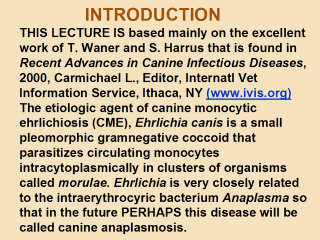| front |1 |2 |3 |4 |5 |6 |7 |8 |9 |10 |11 |12 |13 |14 |15 |16 |17 |18 |19 |20 |21 |review |
 |
The present
taxonomy which is most likely to change is: Ehrlichia
Moshkovski 1945, genus. Type genus of the family Ehrlichiaceae
Moshkovski 1945 [Approved Lists 1980 or bacteria]; type genus of the tribe
Ehrlichieae Philip 1957 [Approved Lists 1980]). —Type species:
Ehrlichia canis (Donatien and Lestoquard 1935) Moshkovski 1945 Human anaplasmosis used to be called erhlichiosis or human granulocytic ehrlichiosis (HGE). This anemia is caused by Anaplasma phagocytophila, Ehrlichia equi and HGE which seem to be one species that has 3 or more strains. Also, Ehrlichia seems to be a synonym of Anaplasma. The sequencing of nucleotides to yield some sort of phylogeny has not yet progressed far enough in this group of microorganisms so that definitive statements can always be made. How closely related are E. equi and E. canis ? The new taxonomy is yet to come. E. canis was first recognized in Algeria in 1935. It assumed great importance during the Vietnam war, causing the death of hundreds of military dogs. The disease has received further attention in 1987 when the closely related organism E. chaffeensis that seems to be a synonym of E. canis was identified as the cause of human monocytic ehrlichiosis now called human anaplasmosis. In 1996, E. chaffeensis was shown to cause disease symptoms in dogs indistinguishable from E. canis infection. |